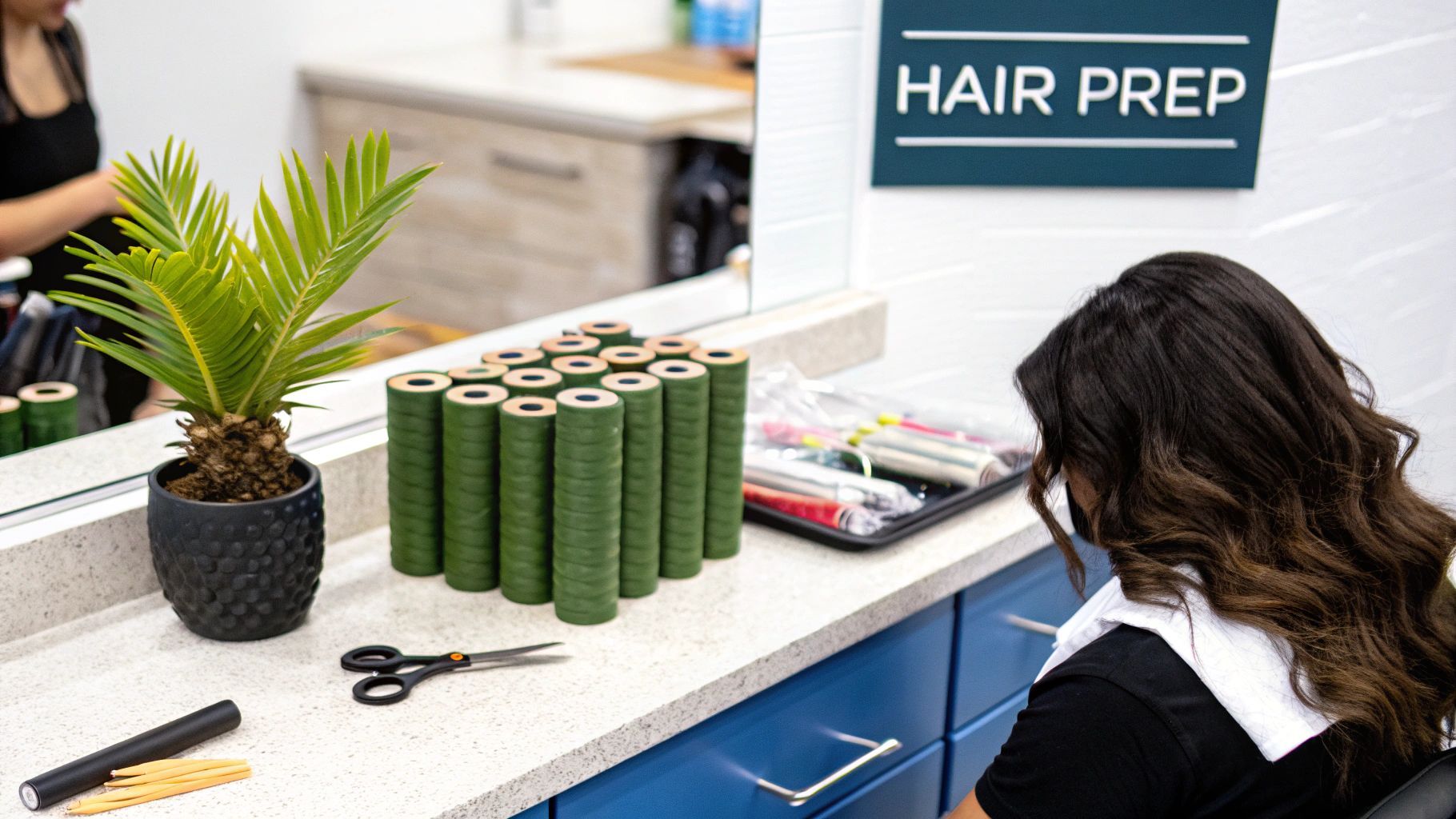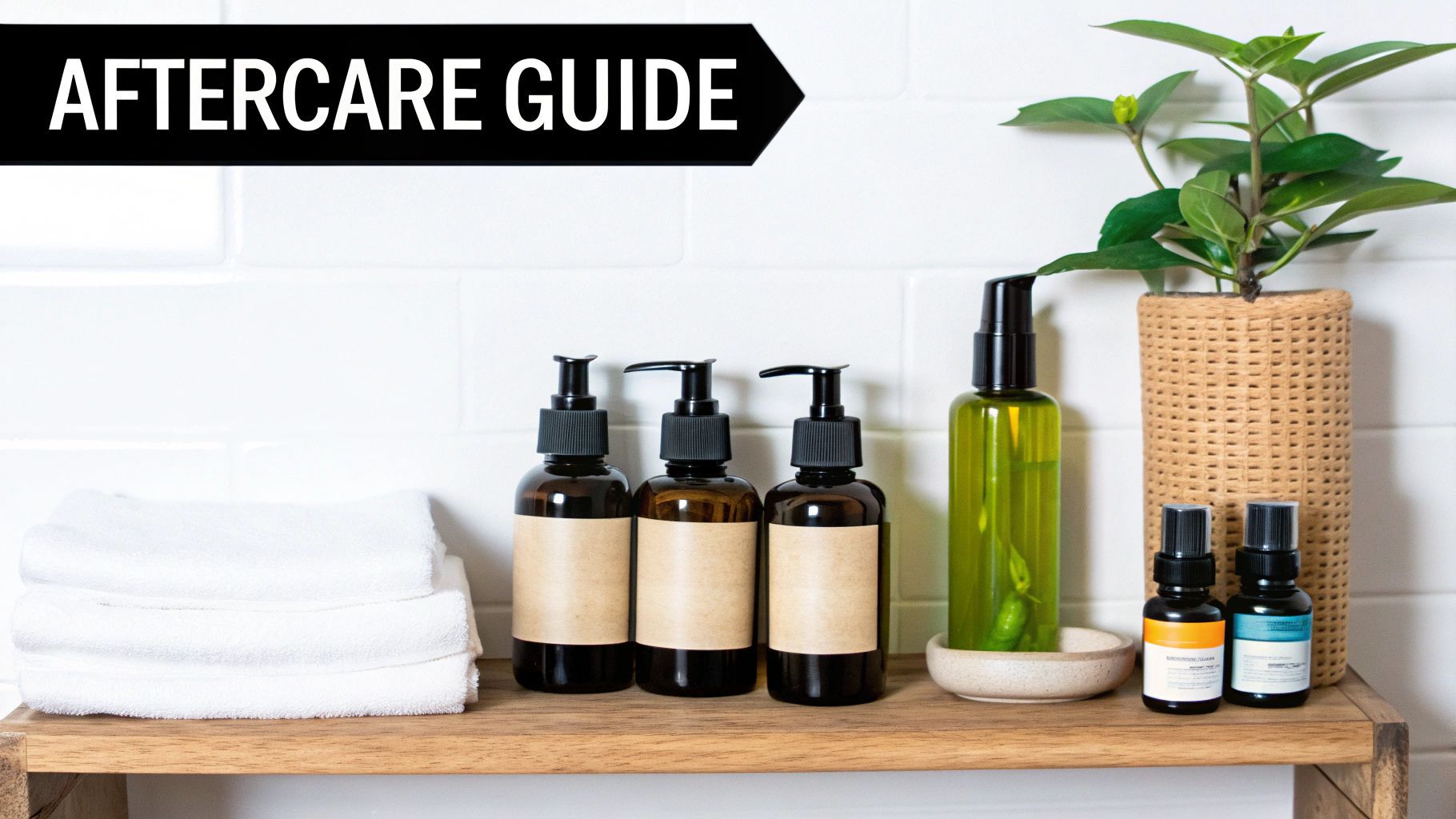How to Palm Roll locs for Healthy Locs
How to Palm Roll locs for Healthy Locs
Palm rolling is one of the most fundamental things you can do to help your hair form tight, uniform locs. If you have starter locs, this simple, repetitive motion is your best friend. It helps tuck in all the loose hairs, tames frizz, and guides your dreadlocks to mature into that classic, well-kept style. It’s the secret sauce to getting your hair to lock up neatly right from the start.
Why Palm Rolling is a Game-Changer for Your Locs
Before we get into the how, let’s talk about the why. It’s really important to get why this simple habit works so well. Don't think of palm rolling as forcing your hair into submission; it's more like gentle, consistent coaching.
When your locs are new, all those individual hair strands are still learning how to tangle and mesh together. Palm rolling just speeds things up. The friction and light pressure from your hands encourage them to form a solid, round shape instead of doing their own thing.
Regularly palm rolling is especially key for avoiding common headaches like flat spots or tips that want to unravel, which happens a lot in the early days. By making it part of your routine, you’re basically building a strong foundation for the future of your locs. It’s what separates locs that grow wild and unpredictable from ones that mature with a clean, intentional look.
The Foundation of Healthy Loc Maintenance
The real power of palm rolling is how it trains your hair over time. This isn’t an instant-fix kind of thing. You won't roll your locs once and have them be perfect. The magic is in doing it consistently.
With every session, you’re helping tighten the core of each loc, making it denser and stronger as it grows.
The whole point of palm rolling is to set up a disciplined growth pattern. You’re teaching your hair how to form, packing the new growth and stray fuzzies back into the loc itself. This is what leads to that sleek, uniform appearance down the line.
Most locticians will tell you this is a cornerstone of good maintenance. If your locs are brand new or freshly crocheted, spending just 30 seconds per dread each day can make a massive difference in keeping them round and tight. For a deeper dive into this, you can check out some great tips on daily dreadlock care on radiantrootsstudio.biz. It's a small time investment that pays off big time for the health and look of your locs.

Here's some good news: you don't need a bunch of fancy tools or expensive products to get a great palm roll. This is one of those loc maintenance techniques that’s beautifully simple. Forget the complicated gadgets—it’s all about working with what you’ve got.
The most important thing is to start with clean, slightly damp hair. You never, ever want to roll bone-dry locs. That friction is a recipe for breakage and damage. A fresh wash is the perfect starting point.
What to Grab
When it comes to products, a "less is more" approach will save your locs from dreaded product buildup. The goal is just a little moisture and grip, not to coat your hair in gunk.
A Light Locking Gel or Cream: Think small. A pea-sized dab is plenty. I always recommend water-based formulas because they won’t leave that sticky, flaky residue behind.
A Moisturizing Spray: No need to buy anything special! A simple spray bottle with water and a splash of rosewater or a bit of your favorite light leave-in conditioner is perfect. This keeps your hair flexible and happy while you work.
Seriously, avoid heavy waxes like beeswax at all costs. I know they were popular back in the day, but they are notorious for creating a gross, greasy buildup inside the loc that’s almost impossible to get out. Trust me on this one.
That’s pretty much it. Your toolkit is just clean, damp hair, a light-handed product, and your own two hands. Keeping it minimal is the real secret to healthy locs.
Finding Your Personal Rhythm
Look, everyone’s hair is unique. The pressure that works perfectly for tight, coily hair might be too much for someone with a wavier texture. Over time, you'll develop a personal touch. The most important thing is to listen to your hair.
Here are a few things to keep in mind as you find your groove:
Feel the change. As you roll, you should literally feel the loc getting a bit tighter and more solid. That's how you know it's working and those loose hairs are being tucked in.
Stay consistent. Try to use the same steady pressure from the root all the way down to the tip. This is the secret to getting that smooth, even look.
Work in sections. Don't try to tackle your whole head at once. Use clips to separate the hair you've finished from the hair you haven't. It keeps you focused and prevents everything from turning into a tangled mess.
Ultimately, getting the hang of palm rolling is all about muscle memory. After a few sessions, you won't even have to think about it. The motion will become second nature, turning maintenance day into a simple, almost meditative, ritual.
Finding Your Perfect Palm Rolling Schedule
So, what's the magic number for how often you should be palm rolling? The honest answer is... there isn't one. If you ask ten different people with locs, you’ll probably get ten different answers. That's because the perfect schedule is completely unique to your hair and where you are in your loc journey.
The two biggest things to consider are your hair texture and how mature your locs are. Think about it: softer, straighter hair types are much more likely to slip and unravel, especially when they're new. Those locs need a bit more frequent, gentle encouragement from palm rolling to really compact and hold their shape.
On the flip side, coily and kinky hair textures tend to lock up almost on their own. That natural tendency to mesh means you might not need to be as hands-on to keep them tight. It really comes down to finding a rhythm that works for you. You can find more great insights into how hair texture affects your locs on YouTube.
Adjusting as Your Locs Mature
Your palm rolling routine isn't something you set and forget. It needs to change right along with your hair. Each stage of the loc journey has its own quirks, and knowing what your locs need is the key to healthy, strong growth. Rolling mature locs too often can cause damage, but not rolling new locs enough can really slow down the locking process.
Starter Locs (0-6 months): Welcome to the high-maintenance phase. Your brand-new locs are delicate and need almost daily attention. A quick palm roll every single day helps train the hair, keep frizz under control, and stop them from completely unraveling after you wash them.
Teenage Locs (6-12 months): You're in the "budding" stage now, where the inside of your locs is really starting to form. You can probably relax a bit and scale back to palm rolling every few days, or maybe just after a wash.
Mature Locs (1 year+): At this point, your locs are solid and pretty self-sufficient. Palm rolling is less of a daily chore and more of a touch-up tool. A good session after washing is usually all you need to keep them looking sharp.
Your hair will always tell you what it needs. If you see a lot of new frizz, loose hairs, or notice some locs getting flat, that's your cue to give them a gentle roll. If they feel tight and look good, let them be.
Common Palm Rolling Mistakes to Avoid

Palm rolling seems straightforward, right? But I’ve seen a few common slip-ups that can really set back your progress. Honestly, knowing what not to do is half the battle. If you can steer clear of these pitfalls, your loc journey will be a whole lot smoother.
The biggest mistake I see? Using way too much pressure. It's a natural instinct to roll hard, thinking you’re forcing the hair to lock faster. But all that aggressive rolling actually thins out your roots, creating weak spots that can eventually lead to breakage. Think gentle compression, not brute force.
Another classic error is trying to palm roll bone-dry hair. Your locs are at their most brittle when they're dry, and all that friction just creates frizz and damage. Always make sure your hair is slightly damp—it gives it the flexibility it needs to be worked without snapping.
Product and Frequency Missteps
Using the wrong products is a recipe for disaster. Stay far, far away from heavy waxes and anything with beeswax. Seriously. That stuff builds up deep inside the loc, attracting lint and dirt like a magnet, and it's nearly impossible to wash out.
If there's one thing to take away, it's this: heavy product buildup can ruin healthy locs faster than anything else. Stick to light, water-based locking gels or even just a simple moisturizing spray to get a bit of grip without the gunk.
Finally, don't overdo it. It's easy to get obsessed, but rolling your hair too often puts a ton of stress on your scalp and roots. While starter locs do need a lot of attention, mature locs don't need to be rolled every week. Listen to your hair—if your locs are already feeling tight and looking neat, let them be. There’s no one-size-fits-all schedule here.
Got Questions About Palm Rolling?
You're not alone! Let's tackle some of the most common questions that pop up. Nailing these details can be a game-changer for your locs.
Can I Palm Roll My Locs When They're Dry?
Please don't. Rolling your locs when they're bone-dry creates a ton of friction, which is a one-way ticket to frizz and breakage. You always want to work with hair that’s at least a little damp.
Even a quick spritz with some water or a light leave-in conditioner is enough to give the hair some flexibility. This helps everything compact down smoothly without roughing up the cuticle.
How Hard Should I Actually Press?
This is where a lot of people go wrong. The key is gentle, consistent pressure, not a death grip. Think of it like you're rolling a delicate piece of clay between your hands. You want just enough pressure to compress and shape it, not flatten it.
Going too hard can seriously thin out your roots over time and even cause breakage.
The big takeaway here? Palm rolling is all about finesse, not force. If your scalp hurts or you hear little snapping sounds, you are pressing way too hard. Back off and let the steady, rolling motion do the work.
How Often Should I Be Palm Rolling?
Honestly, it all comes down to the age and stage of your locs. In the beginning, when your locs are still forming, palm rolling is super important for shaping them. But as they mature and tighten up on their own, you'll find you need to do it less and less.
The care you put in during those early months really sets the foundation for how your locs will look and feel for years to come. Pay attention to how your hair responds and you'll find the right rhythm. You can get a great visual guide on this crucial phase on YouTube.
Ready to give your locs the love they deserve from a pro?
At Royal Rootz Head Spa & Loc Salon, we blend deep hair science with true artistry to make sure your locs are not just beautiful, but healthy from the scalp out. Book your appointment with us today and let's get your hair journey on the right track.